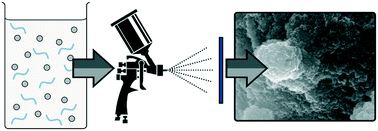A general formulation approach for the fabrication of water repellent materials: how composition can impact resilience and functionality†
Abstract
Superhydrophobic polymer–nanoparticle composite (SPNC) materials are considered to be superior to their molecular equivalents, due to their enhanced functional properties. In this work, we systematically formulate a library of SPNC coatings and demonstrate an interchangeable three component system. Whereby, implementing key formulation principles enables the use of a wide range of polymer and nanoparticulate materials to generate highly water repellent coatings (both solution-based and ‘solvent-free’). Herein, we report how alternating formulation composition can impact overall functionality of the resultant material, and explore the effects this has on; water repellency, ability to self-clean and UV resilience, for various systems. Additionally, confocal fluorescence microscopy was used to shed light on the differences in composite architecture between thermosetting and thermoplastic polymers. When designing coatings for applied self-cleaning technologies, such as; paints, external building materials and industrial processes, these are crucial factors to consider to ensure coatings remain functional throughout their lifecycle.



 Please wait while we load your content...
Please wait while we load your content...